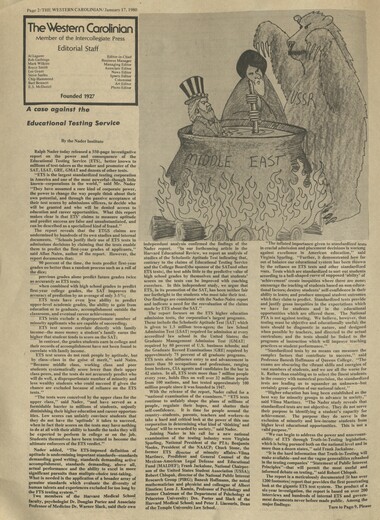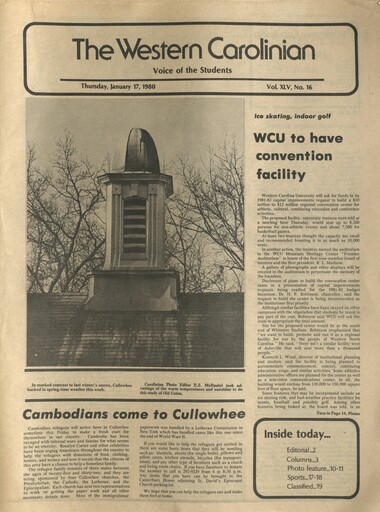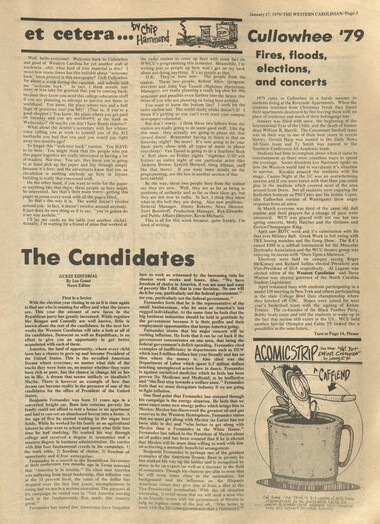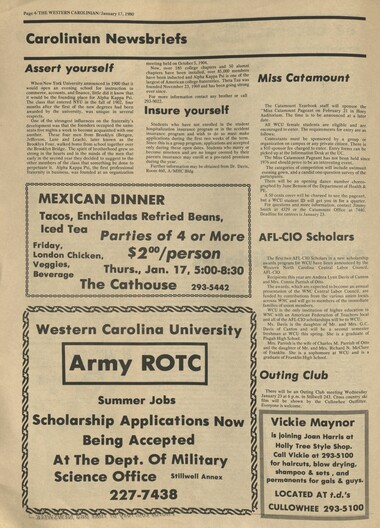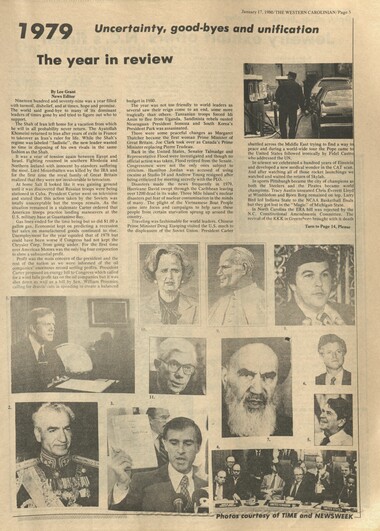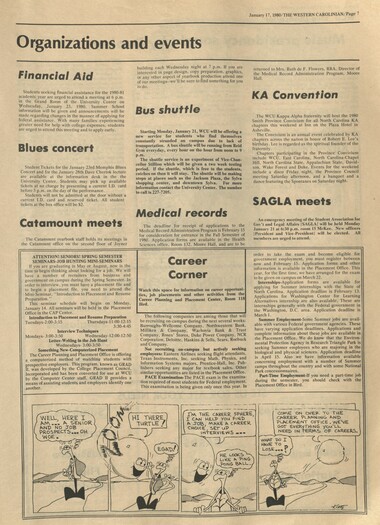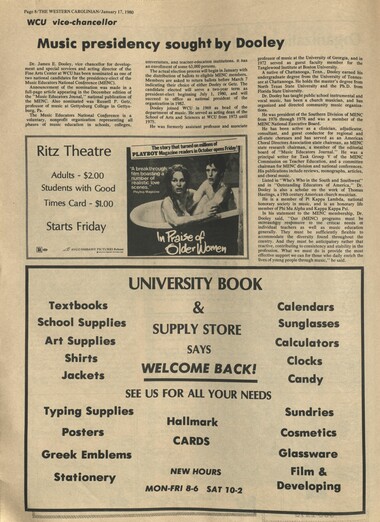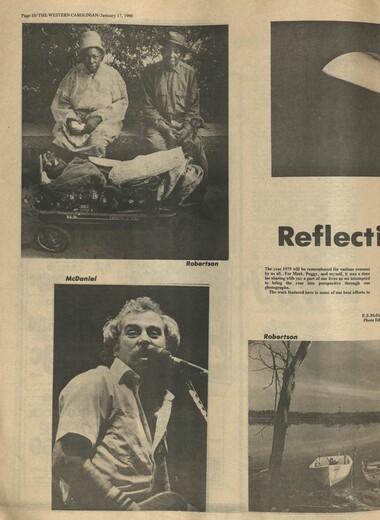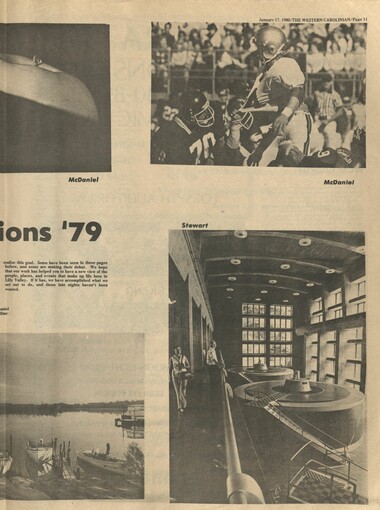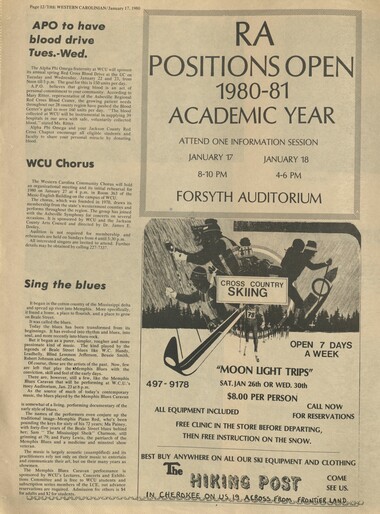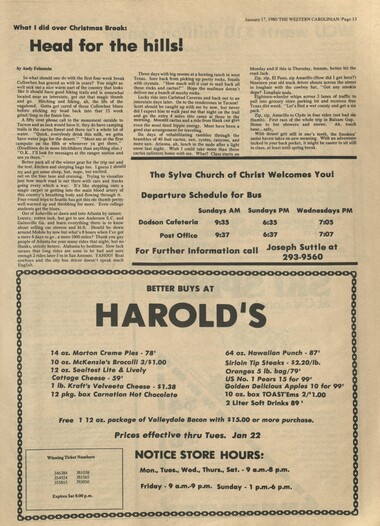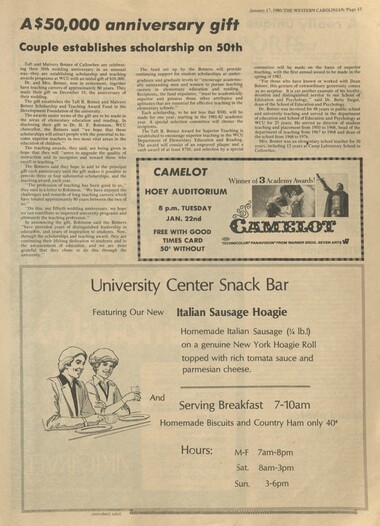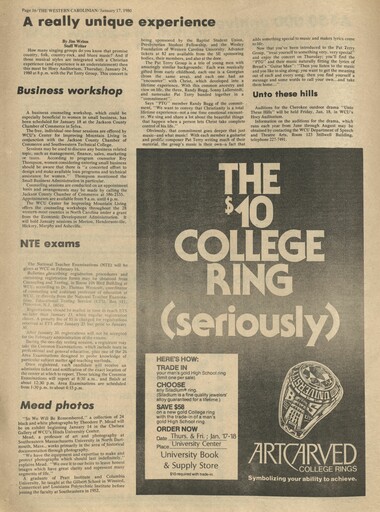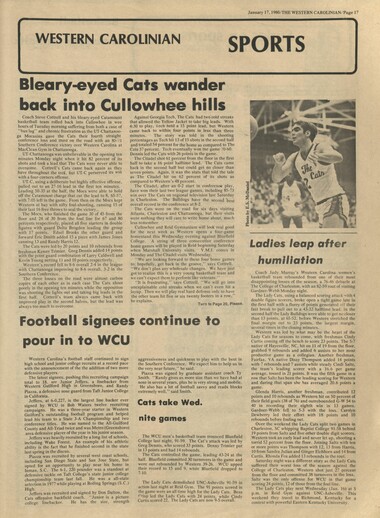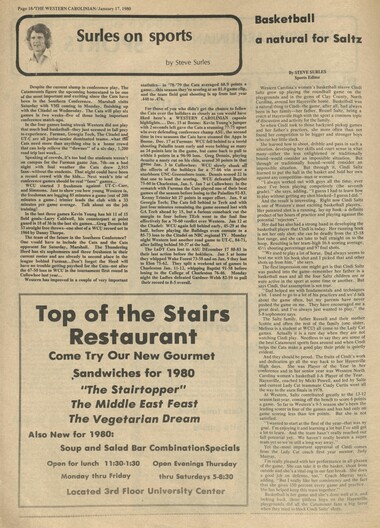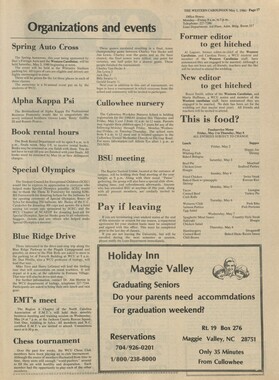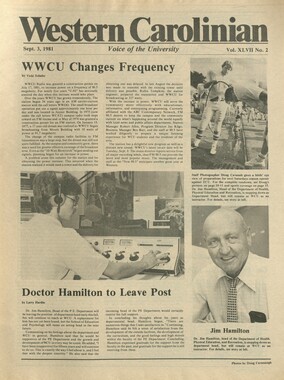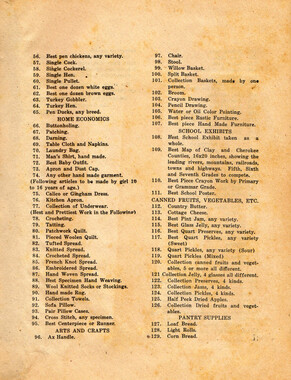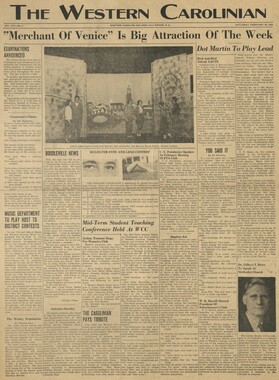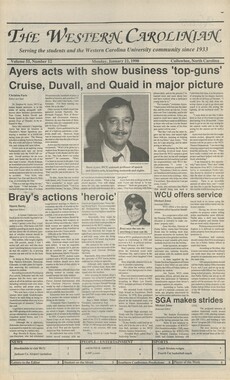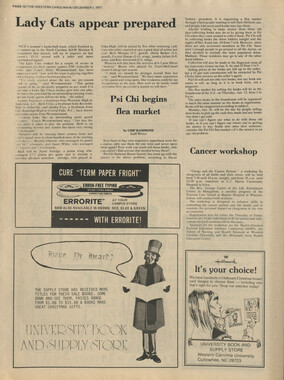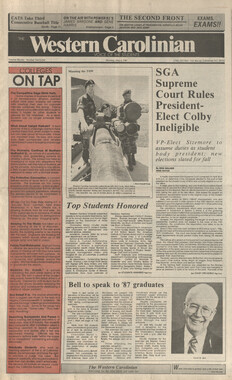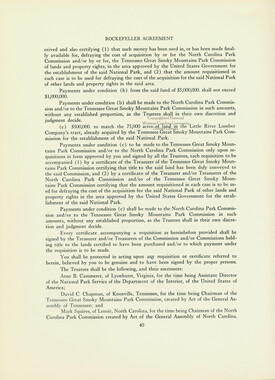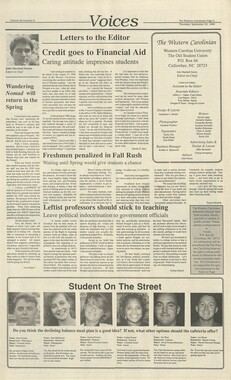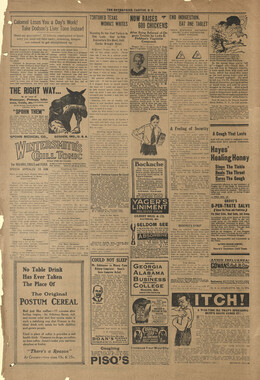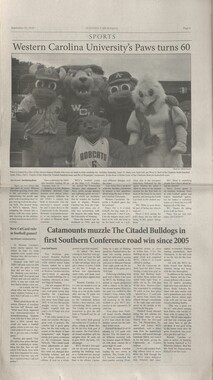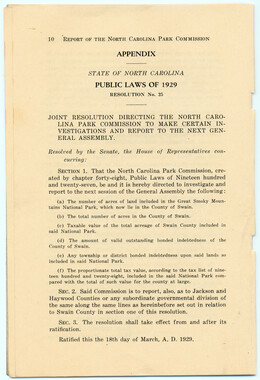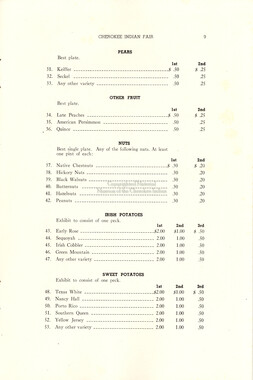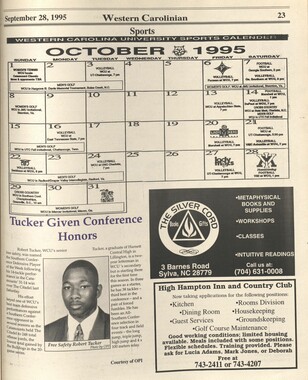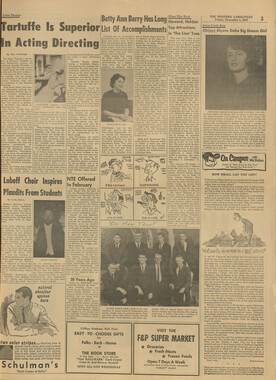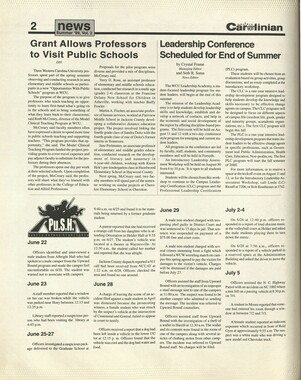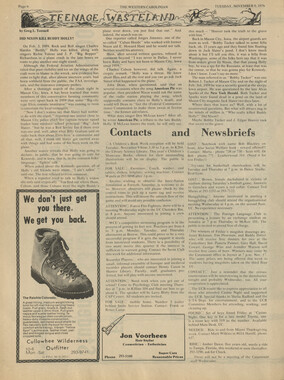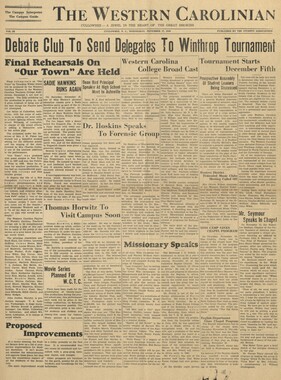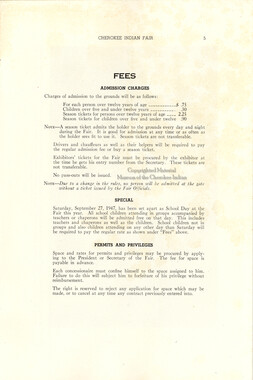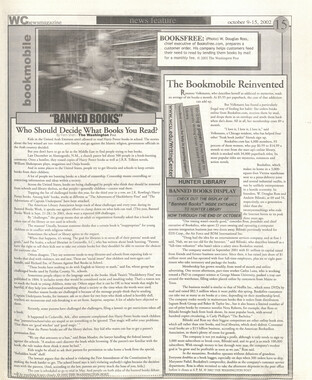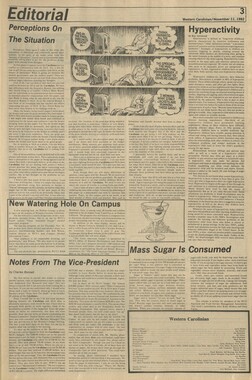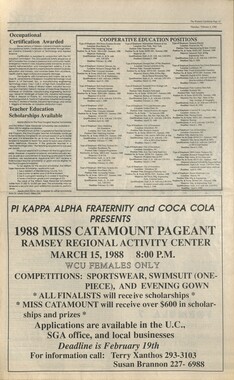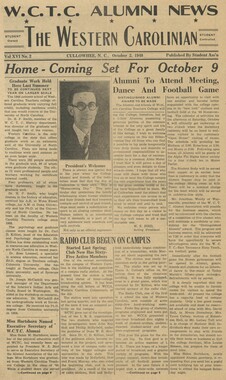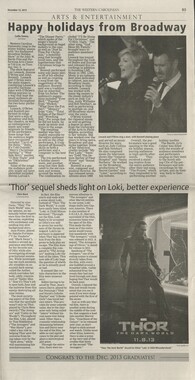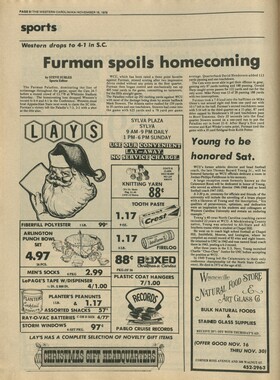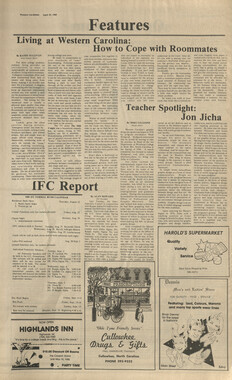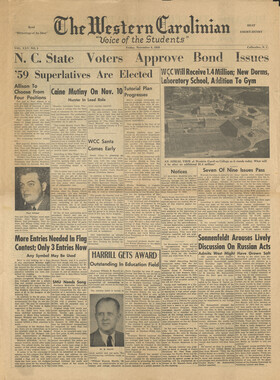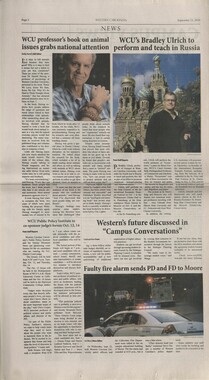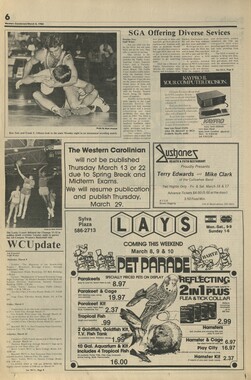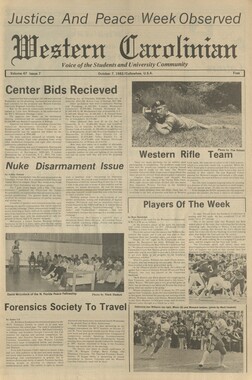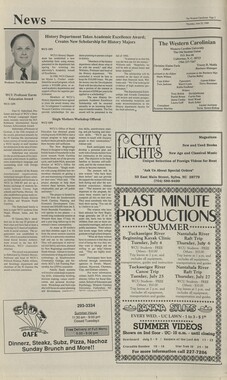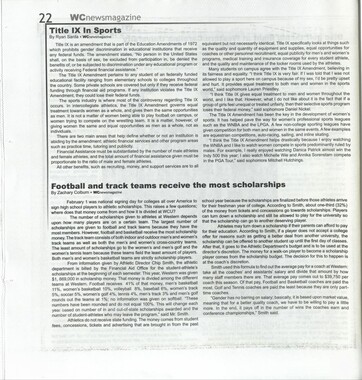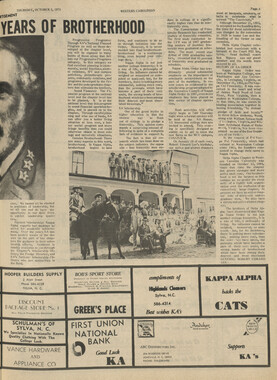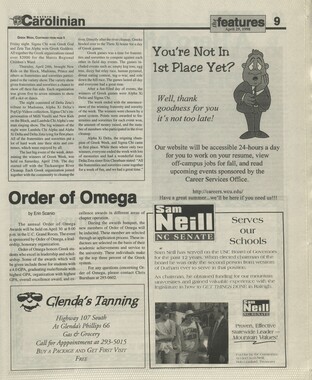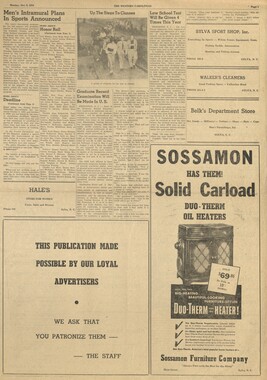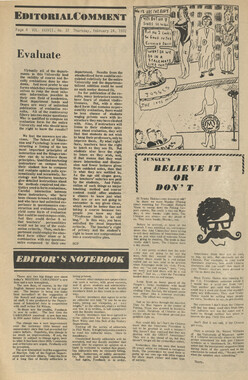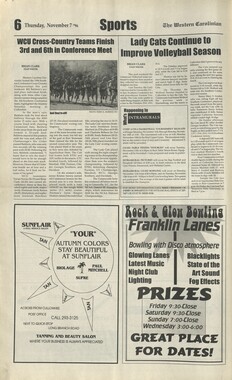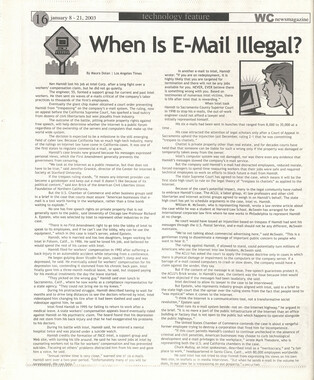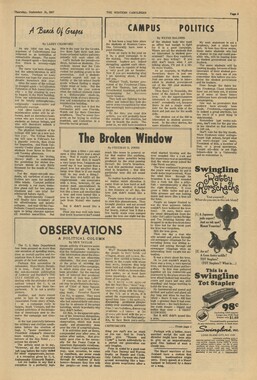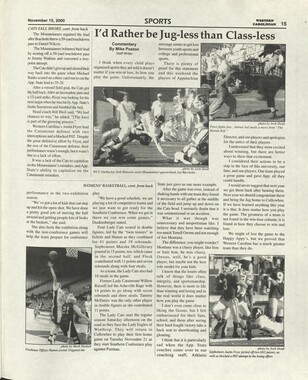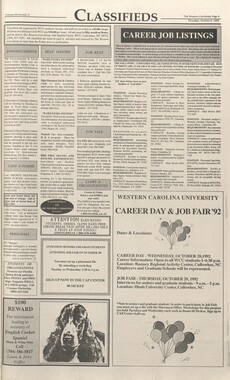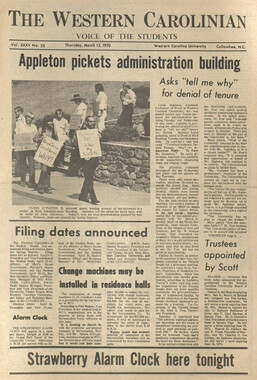Western Carolina University (21)
View all
- Canton Champion Fibre Company (2308)
- Cherokee Traditions (291)
- Civil War in Southern Appalachia (165)
- Craft Revival (1942)
- George Masa Collection (137)
- Great Smoky Mountains - A Park for America (3080)
- Highlights from Western Carolina University (422)
- Horace Kephart (998)
- Journeys Through Jackson (159)
- LGBTQIA+ Archive of Jackson County (90)
- Oral Histories of Western North Carolina (318)
- Picturing Appalachia (6617)
- Stories of Mountain Folk (413)
- Travel Western North Carolina (153)
- Western Carolina University Fine Art Museum Vitreograph Collection (129)
- Western Carolina University Herbarium (92)
- Western Carolina University: Making Memories (738)
- Western Carolina University Publications (2491)
- Western Carolina University Restricted Electronic Theses and Dissertations (146)
- Western North Carolina Regional Maps (71)
- World War II in Southern Appalachia (131)
University of North Carolina Asheville (6)
View all
- Allanstand Cottage Industries (62)
- Appalachian National Park Association (53)
- Bennett, Kelly, 1890-1974 (1463)
- Berry, Walter (76)
- Brasstown Carvers (40)
- Carver, George Washington, 1864?-1943 (26)
- Cathey, Joseph, 1803-1874 (1)
- Champion Fibre Company (233)
- Champion Paper and Fibre Company (297)
- Cherokee Indian Fair Association (16)
- Cherokee Language Program (22)
- Crowe, Amanda (40)
- Edmonston, Thomas Benton, 1842-1907 (7)
- Ensley, A. L. (Abraham Lincoln), 1865-1948 (275)
- Fromer, Irving Rhodes, 1913-1994 (70)
- George Butz (BFS 1907) (46)
- Goodrich, Frances Louisa (120)
- Grant, George Alexander, 1891-1964 (96)
- Heard, Marian Gladys (60)
- Kephart, Calvin, 1883-1969 (15)
- Kephart, Horace, 1862-1931 (313)
- Kephart, Laura, 1862-1954 (91)
- Laney, Gideon Thomas, 1889-1976 (439)
- Masa, George, 1881-1933 (61)
- McElhinney, William Julian, 1896-1953 (44)
- Niggli, Josephina, 1910-1983 (10)
- North Carolina Park Commission (105)
- Osborne, Kezia Stradley (9)
- Owens, Samuel Robert, 1918-1995 (11)
- Penland Weavers and Potters (36)
- Roberts, Vivienne (15)
- Roth, Albert, 1890-1974 (142)
- Schenck, Carl Alwin, 1868-1955 (1)
- Sherrill's Photography Studio (2565)
- Southern Highland Handicraft Guild (127)
- Southern Highlanders, Inc. (71)
- Stalcup, Jesse Bryson (46)
- Stearns, I. K. (213)
- Thompson, James Edward, 1880-1976 (226)
- United States. Indian Arts and Crafts Board (130)
- USFS (683)
- Vance, Zebulon Baird, 1830-1894 (1)
- Weaver, Zebulon, 1872-1948 (58)
- Western Carolina College (230)
- Western Carolina Teachers College (282)
- Western Carolina University (2008)
- Western Carolina University. Mountain Heritage Center (18)
- Whitman, Walt, 1819-1892 (10)
- Wilburn, Hiram Coleman, 1880-1967 (73)
- Williams, Isadora (3)
- Cain, Doreyl Ammons (0)
- Crittenden, Lorraine (0)
- Rhodes, Judy (0)
- Smith, Edward Clark (0)
- Appalachian Region, Southern (3032)
- Asheville (N.C.) (1945)
- Avery County (N.C.) (26)
- Blount County (Tenn.) (195)
- Buncombe County (N.C.) (1680)
- Cherokee County (N.C.) (283)
- Clay County (N.C.) (556)
- Graham County (N.C.) (238)
- Great Smoky Mountains National Park (N.C. and Tenn.) (535)
- Haywood County (N.C.) (3573)
- Henderson County (N.C.) (70)
- Jackson County (N.C.) (4926)
- Knox County (Tenn.) (35)
- Knoxville (Tenn.) (13)
- Lake Santeetlah (N.C.) (10)
- Macon County (N.C.) (421)
- Madison County (N.C.) (216)
- McDowell County (N.C.) (39)
- Mitchell County (N.C.) (135)
- Polk County (N.C.) (35)
- Qualla Boundary (982)
- Rutherford County (N.C.) (78)
- Swain County (N.C.) (2185)
- Transylvania County (N.C.) (270)
- Watauga County (N.C.) (12)
- Waynesville (N.C.) (86)
- Yancey County (N.C.) (72)
- Aerial Photographs (3)
- Aerial Views (60)
- Albums (books) (4)
- Articles (1)
- Artifacts (object Genre) (228)
- Bibliographies (1)
- Biography (general Genre) (2)
- Cards (information Artifacts) (38)
- Clippings (information Artifacts) (193)
- Copybooks (instructional Materials) (3)
- Crafts (art Genres) (622)
- Depictions (visual Works) (21)
- Design Drawings (1)
- Digital Moving Image Formats (2)
- Drawings (visual Works) (185)
- Envelopes (115)
- Exhibitions (events) (1)
- Facsimiles (reproductions) (1)
- Fiction (general Genre) (4)
- Financial Records (12)
- Fliers (printed Matter) (67)
- Glass Plate Negatives (381)
- Guidebooks (2)
- Internegatives (10)
- Interviews (823)
- Land Surveys (102)
- Letters (correspondence) (1070)
- Manuscripts (documents) (618)
- Maps (documents) (177)
- Memorandums (25)
- Minutes (administrative Records) (59)
- Negatives (photographs) (6090)
- Newsletters (1290)
- Newspapers (2)
- Notebooks (8)
- Occupation Currency (1)
- Paintings (visual Works) (1)
- Pen And Ink Drawings (1)
- Periodicals (194)
- Personal Narratives (10)
- Photographs (12977)
- Plans (maps) (1)
- Poetry (6)
- Portraits (4568)
- Postcards (329)
- Programs (documents) (181)
- Publications (documents) (2444)
- Questionnaires (65)
- Relief Prints (26)
- Sayings (literary Genre) (1)
- Scrapbooks (282)
- Sheet Music (2)
- Slides (photographs) (402)
- Songs (musical Compositions) (2)
- Sound Recordings (802)
- Specimens (92)
- Speeches (documents) (18)
- Tintypes (photographs) (8)
- Transcripts (329)
- Text Messages (0)
- A.L. Ensley Collection (275)
- Appalachian Industrial School Records (7)
- Appalachian National Park Association Records (336)
- Axley-Meroney Collection (2)
- Bayard Wootten Photograph Collection (20)
- Bethel Rural Community Organization Collection (7)
- Blumer Collection (5)
- C.W. Slagle Collection (20)
- Canton Area Historical Museum (2110)
- Carlos C. Campbell Collection (462)
- Cataloochee History Project (64)
- Cherokee Studies Collection (4)
- Daisy Dame Photograph Album (5)
- Daniel Boone VI Collection (1)
- Doris Ulmann Photograph Collection (112)
- Elizabeth H. Lasley Collection (1)
- Elizabeth Woolworth Szold Fleharty Collection (4)
- Frank Fry Collection (95)
- George Masa Collection (173)
- Gideon Laney Collection (452)
- Hazel Scarborough Collection (2)
- Hiram C. Wilburn Papers (28)
- Historic Photographs Collection (236)
- Horace Kephart Collection (861)
- Humbard Collection (33)
- Hunter and Weaver Families Collection (1)
- I. D. Blumenthal Collection (4)
- Isadora Williams Collection (4)
- Jesse Bryson Stalcup Collection (47)
- Jim Thompson Collection (224)
- John B. Battle Collection (7)
- John C. Campbell Folk School Records (80)
- John Parris Collection (6)
- Judaculla Rock project (2)
- Kelly Bennett Collection (1482)
- Love Family Papers (11)
- Major Wiley Parris Civil War Letters (3)
- Map Collection (12)
- McFee-Misemer Civil War Letters (34)
- Mountain Heritage Center Collection (4)
- Norburn - Robertson - Thomson Families Collection (44)
- Pauline Hood Collection (7)
- Pre-Guild Collection (2)
- Qualla Arts and Crafts Mutual Collection (12)
- R.A. Romanes Collection (681)
- Rosser H. Taylor Collection (1)
- Samuel Robert Owens Collection (94)
- Sara Madison Collection (144)
- Sherrill Studio Photo Collection (2558)
- Smoky Mountains Hiking Club Collection (616)
- Stories of Mountain Folk - Radio Programs (374)
- The Reporter, Western Carolina University (510)
- Venoy and Elizabeth Reed Collection (16)
- WCU Gender and Sexuality Oral History Project (36)
- WCU Mountain Heritage Center Oral Histories (25)
- WCU Oral History Collection - Mountain People, Mountain Lives (71)
- WCU Students Newspapers Collection (1923)
- Western North Carolina Tomorrow Black Oral History Project (69)
- William Williams Stringfield Collection (2)
- Zebulon Weaver Collection (109)
- African Americans (390)
- Appalachian Trail (35)
- Artisans (521)
- Cherokee art (84)
- Cherokee artists -- North Carolina (10)
- Cherokee language (21)
- Cherokee pottery (101)
- Cherokee women (208)
- Church buildings (190)
- Civilian Conservation Corps (U.S.) (111)
- College student newspapers and periodicals (2012)
- Dams (108)
- Dance (1023)
- Education (222)
- Floods (63)
- Folk music (1015)
- Forced removal, 1813-1903 (2)
- Forest conservation (220)
- Forests and forestry (1198)
- Gender nonconformity (4)
- Great Smoky Mountains National Park (N.C. and Tenn.) (181)
- Hunting (47)
- Landscape photography (25)
- Logging (122)
- Maps (83)
- Mines and mineral resources (9)
- North Carolina -- Maps (18)
- Paper industry (38)
- Postcards (255)
- Pottery (135)
- Railroad trains (72)
- Rural electrification -- North Carolina, Western (3)
- School integration -- Southern States (2)
- Segregation -- North Carolina, Western (5)
- Slavery (5)
- Sports (452)
- Storytelling (243)
- Waterfalls -- Great Smoky Mountains (N.C. and Tenn.) (66)
- Weaving -- Appalachian Region, Southern (280)
- Wood-carving -- Appalachian Region, Southern (328)
- World War, 1939-1945 (174)
Western Carolinian Volume 45 Number 16
Item
Item’s are ‘child’ level descriptions to ‘parent’ objects, (e.g. one page of a whole book).
-
-
Page 2/THE WESTERN CAROLINIAN/January 17, 1980 TheVvfestern Cardinion Member of the Intercollegiate Press Editorial Staff AlLagano Rob Gathings Mark Wilkins Royce Smith Lee Grant Steve Surles Chip Hammond Bart Bennett E.S. McDaniel Editor-in-Chief Business Manager Managing Editor Associate Editor News Editor Sports Editor Columnist Art Editor Photo Editor Founded 1927 A case against the Educational Testing Service By the Nader Institute Ralph Nader today released a 550-page investigative report on the power and consequence of the Educational Testing Service [ETS], better known to millions of test-takers as the maker and promoter of the SAT, LSAT, GRE, GMAT and dozens of other tests. "ETS is the largest standardized testing corporation in America and one of the most powerful-though little known-corporations in the world," said Mr. Nader "They have assumed a rare kind of corporate power, the power to change the way people think about their own potential, and through the passive acceptance of their test scores by admissions officers, to decide who will be granted and who will be denied access to ' education and career opportunities. What this report makes clear is that ETS' claims to measure aptitude and predict success are false and unsubstantiated, and can be described as a specialized kind of fraud." The report reveals that the ETGS claims are undermined by hundreds of its own studies and internal documents. "Schools justify their use of ETS tests in admissions decisions by claiming that the tests enable them to predict the first-year grades of applicants," said Allan Nairn, author of the report. However, the report documents that: 90 percent of the time, the tests predict first-year grades no better than a random process such as a roll of the dice; previous grades alone predict future grades twice as accurately as ETS tests; when combined with high school grades to predict first-year college grades, the SAT improves the accuracy of prediction by an average of only 3-5%; ETS tests have even less ability to predict upper-level academic grades, the ability to gain from education or to graduate, accomplishment outside the classroom, and eventual career achievement; ETS tests exclude a disproportionate number of minority applicants who are capable of succeeding; - ETS test scores correlate directly with family income-the more money a student's family earns the higher that student tends to score on the SAT; in contrast, the grades students earn in college and their records of accomplishment have not been found to correlate with family income. ETS test scores do not rank people by aptitude, but by class-class in the guise of merit," said Nairn. "Because middle class, working class and poor students systematically score lower than their upper class peers, and the tests do not accurately predict who will do well, a disproportionate number of minority and less wealthy students who could succeed if given the chance are excluded because of reliance on the ETS tests." "The tests were conceived by the upper class for the upper class," said Nader, "and have served as a formidable barrier to millions of students, unjustly diminishing their higher education and career opportunities. Low scores can unfairly convince students that they do not have the 'aptitude' it takes to succeed, when in fact their scores on the tests may have nothing to do at all with their ability to handle the tasks they will be expected to perform in college or on the job. Students themselves have been trained to become the ultimate enforcers of the ETS verdict." Nader added, "The ETS-imposed definition of aptitude is undermining important standards-standards demanding good writing, standards demanding active accomplishment, standards demanding, above all, actual performance and the ability to excel in more significant pursuits than multiple-choice test-taking. What is needed is the application of a broader array of genuine standards which evaluate the diversity of human talents and experiences excluded for too long by the FTS testing system." Two members of the Harvard Medical School faculty, psychologist Dr. Douglas Porter and Associate Professor of Medicine Dr. Warner Slack, said their own independant analysis confirmed the findings of the Nader report. "In our forthcoming article in the Harvard Educational Review, we report an analysis of studies of the Scholastic Aptitude Test indicating that, contrary to the claims of Educational Testing Service and the College Board [the sponsor of the SATand other ETS tests], the test adds little to the predictive value of high school grades by themselves and that students' scores on the tests can be improved with coaching exercises. In this independent study, we argue that ETS, in its promotion of the SAT, has been neither fair nor forthright to the students who must take their test. Our findings are consistant with the Nader-Nairn report and indicate a need for the reevaluation of the claims made by ETS about the SAT." The report focuses on the ETS higher education admission tests, the corporation's largest programs. These include the Scholastic Aptitude Test [SAT] which is given to 1.5 million teen-agers; the law School Admission Test [LSAT] required for admission at every accredited law school in the United States; the Graduate Management Admission Test [GMAT] required by 80 percent of U.S. business schools; and the Graduate Record Examinations [GRE] required by approximately 75 percent of all graduate programs. ETS tests also influence entry to and advancement in more than 50 occupations and professions, ranging from brokers, CIA agents and candidates for the bar in 42 states. In all, ETS tests more than 7 million people every year, holds files on well over 32 million people from 100 nations, and has tested approximately 100 million people since it was founded in 1947. With the release of the report, Nader called for a "national examination of the examiners." "ETS tests continue to unfairly shape the plans of millions of people, regulate their hopes, and shatter their self-confidence. It is time for people around the country-students, parents, teachers and workers-to take a hard and critical look at the power of this one corporation in determining what kind of 'thinking' and 'talent' will be rewarded by society," said Nader. Joining Nader in his call for a new national examination of the testing industry were Virginia Sparling, National President of the PTA; Benjamin Hooks, President of the NAACP; Chuck Stone, the former ETS director of minority affairs-Vilma Martinez, Predident and General Counsel of the Mexican-American Legal Defense and Educational Fund [MALDEF]; Frank Jackalone, National Chairperson of the United States Student Association [USSA]; Robert Chlopak, director of the National Public Interest Research Group [PIRG]; Banesh Hoffmann, the noted mathematician and physicist and colleague of Albert Einstien; Leon J. Kamin, Professor of Psychology and former Chairman of the Department of Pshchology at Princeton University; Drs. Porter and Slack of the Harvard Medical School; and Peter J. Liacouris, Dean of the Temple University Law School. "The inflated importance given to standardized tests in crucial admission and placement decisions is working against excellence in American education," said Virginia Sparling. "Further, it demonstrated how far out of balance our educational system has been thrown by the reliance on ETS tests and other standardized tests. Tests which are standardized to sort out students according to a bell-shaped curve of supposed 'ability' of 'achievement' create inequities where there are none; encourage the tracking of students based on non-educational factors; destroy students' self-confidence in their ability to learn; and produce unequal student outcomes which they claim to predict. Standardized tests provide and justify gross inequities in the expectations which we have for students and in the educational opportunities which are offered them. The National PTA is not against testing. We believe, however, that testing must be objective and educationally useful; the tests should be diagnostic in nature, and designed when possible by teachers, and directed to the actual curriculum; and the tests should be linked to the programs of instruction which will improve teaching practices or student performance." "Standardized tests by no means can measure the complex factors that contribute to success," said Professor Banesh Hoffmann of Queens College. "The exams are obscuring the vibrant skills and energies of vast numbers of students, and we are all the worse for it. Rather than enabling us to select the finest students in the country with numerical precision, the standardized tests are leading us to squander an unknown-but certainly great-portion of our national talent." "Higher education has long been established as the best way for minority groups to advance in society," said Vilma Martinez. "The Nader study reveals that standardized tests are not objective. They do not serve their purpose in identifying a student's capacity for achievement. The purpose they do serve is the exclusion of minority and low-income students from . higher level educational opportunities. This is not a valid purpose." "We can begin to address the power and unaceount- ability of ETS through Truth-in-Testing legislation, which is being pursued both on the national level and in more than a dozen states," said Frank Jackalone. "K is the hard information that Truth-in-Testing will make available-and not the vague generalities rehashed in the testing companies' "Statement of Public Interest Principles"--that will permit the most useful and informed debate on testing," said Robert Chlopak. The report is a meticulously documented [it has over 1200 footnotes] report that provides the first penetrating look at the gigantic ETS test system. The product of a six-year investigation, the report is based on over 200 interviews and hundreds of internal ETS and government documents never before made public. Among the major findings: Tum ^ pag^ please
Object
Object’s are ‘parent’ level descriptions to ‘children’ items, (e.g. a book with pages).
-
The Western Carolinian is Western Carolina University's student-run newspaper. The paper was published as the Cullowhee Yodel from 1924 to 1931 before changing its name to The Western Carolinian in 1933.
-
